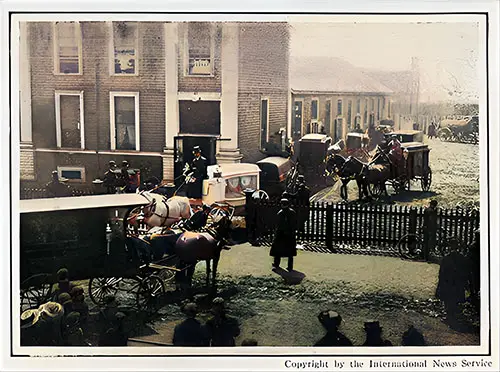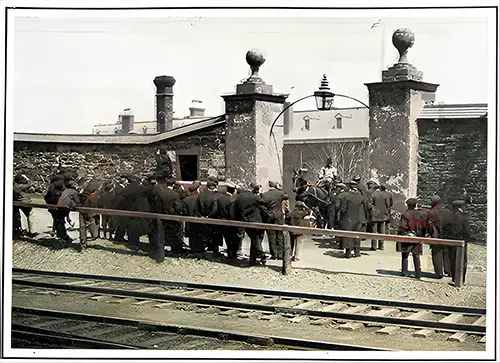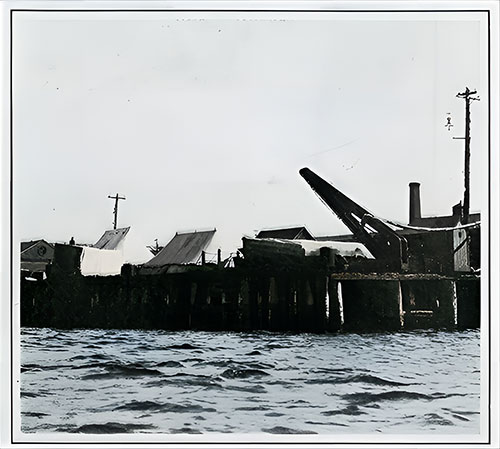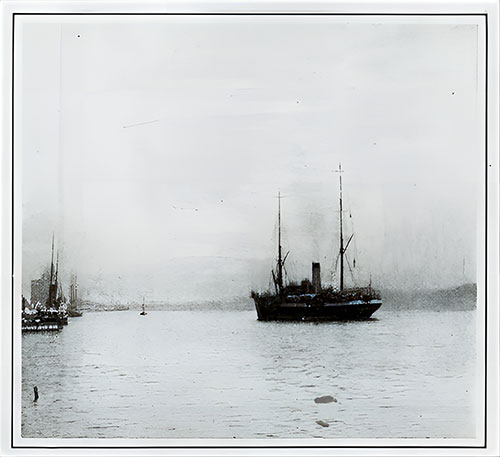The Mackay-Bennett and the Recovery of Titanic Victims: Scenes of Loss and Mourning in Halifax
📌 Explore powerful photographs from the Mackay-Bennett’s mission to recover Titanic victims, capturing the profound human cost and emotional impact of the disaster. Essential for historians, genealogists, and students studying the Titanic and its aftermath.
Scenes at Halifax upon the arrival of the funeral ship “Mackay- Bennett,” bearing bodies recovered from the neighborhood of the titanic disaster, or the 1,635 dead, 306 were picked up by the “MacKay-Bennett,” but it was found necessary to bury 116 of these at sea.
The Mackay-Bennett and its Role in the RMS Titanic Disaster
Overview and Relevance to Ocean Travel 🌍🚢
The RMS Titanic disaster, one of the most tragic maritime events in history, resulted in the loss of over 1,500 lives. In the aftermath, the Mackay-Bennett, a cable-laying ship, was dispatched to recover the bodies of those who had perished in the disaster. This collection of photographs and scenes from Halifax, where the bodies were brought for identification, offers a stark and poignant look at the aftermath of the Titanic tragedy. These images are not only vital for understanding the human cost of the disaster but also provide a glimpse into the logistical and emotional challenges involved in recovering and identifying the victims.
For teachers, students, genealogists, historians, and others, these photographs provide primary source material that helps in understanding the broader social, emotional, and historical context surrounding the Titanic disaster and its aftermath.

The Curling Rink Where the Dead Were Laid out for Inspection. © International News Service. Harper's Weekly (11 May 1912) p. 8a. GGA Image ID # 109f3393fb

Removing the Body of John Jacob Astor from the Dock, © International News Service. Harper's Weekly (11 May 1912) p. 8b. GGA Image ID # 109f7a02ce

The Mackay-Bennett Docking at Her Wharf, Her Deck Loaded with the Rude Pine Boxes Containing the Bodies of the Dead. © International News Service. Harper's Weekly (11 May 1912) p. 8c. GGA Image ID # 109fedf7ad

Tents Used as a Temporary Morgue for the Reception of the Bodies on the Pier. © International News Service. Harper's Weekly (11 May 1912) p. 8d. GGA Image ID # 109ff31932

The Mackay-Bennett Entering Halifax Harbor with Her Cargo of Dead. Harper's Weekly (11 May 1912) p. 8e. GGA Image ID # 10a0130d6f

Vincent Astor and Nicholas Biddle in Halifax Awaiting the Arrival of the Mackay-Bennett. © International News Service. Harper's Weekly (11 May 1912) p. 8f. GGA Image ID # 10a02e3e1b
Noteworthy Content and Engaging Details 📸
1️⃣ The Curling Rink Where the Dead Were Laid Out for Inspection
One of the most haunting images in this collection is that of the curling rink in Halifax where the bodies recovered from the Titanic disaster were laid out for inspection. This temporary morgue, where the victims were identified and prepared for burial, underscores the enormity of the task that faced those who were tasked with recovering and identifying the Titanic’s dead.
📌 Noteworthy Image: The Curling Rink Where the Dead Were Laid Out for Inspection (Harper's Weekly, 11 May 1912). This image presents a somber and chilling reality of the Titanic’s aftermath, giving us a visual record of the human cost of the disaster.
2️⃣ Removing the Body of John Jacob Astor from the Dock
The recovery of prominent passengers, like John Jacob Astor, was widely covered in the media. Astor, one of the wealthiest men in the world at the time, was among the notable victims of the Titanic disaster. This image highlights the emotional and physical toll of identifying and recovering such high-profile individuals.
📌 Noteworthy Image: Removing the Body of John Jacob Astor from the Dock (Harper's Weekly, 11 May 1912). This photograph not only reflects the tragedy of Astor's death but also the profound personal loss experienced by his family and the public.
3️⃣ The Mackay-Bennett Docking at Her Wharf
As the Mackay-Bennett arrived in Halifax with its grim cargo of Titanic victims, the sheer scale of the disaster became even more real. The deck of the ship, loaded with pine boxes containing the bodies of the dead, paints a vivid picture of the solemn responsibility taken on by the ship's crew.
📌 Noteworthy Image: The Mackay-Bennett Docking at Her Wharf (Harper's Weekly, 11 May 1912). This image emphasizes the massive scale of the operation and the heartbreaking reality of the disaster’s aftermath.
4️⃣ Tents Used as a Temporary Morgue for the Reception of the Bodies
After the bodies were brought ashore, they were initially stored in tents on the pier before being moved for identification. This temporary morgue reflects the urgency and grim nature of the situation. The logistics of handling the bodies of so many victims in such a short amount of time highlight the chaos and emotional strain placed on the recovery efforts.
📌 Noteworthy Image: Tents Used as a Temporary Morgue for the Reception of the Bodies on the Pier (Harper's Weekly, 11 May 1912). This photograph provides a clear image of the makeshift facilities used during the identification and recovery process.
5️⃣ Vincent Astor and Nicholas Biddle in Halifax Awaiting the Arrival of the Mackay-Bennett
The personal connections to the Titanic disaster are vividly captured in the image of Vincent Astor (son of John Jacob Astor) and Nicholas Biddle in Halifax, anxiously awaiting the arrival of the Mackay-Bennett. Their presence underscores the personal grief and public attention that the Titanic disaster attracted.
📌 Noteworthy Image: Vincent Astor and Nicholas Biddle in Halifax Awaiting the Arrival of the Mackay-Bennett (Harper's Weekly, 11 May 1912). This poignant moment reflects the emotional toll on those who lost loved ones in the tragedy.
Educational and Historical Relevance 📚🌐
📌 For students and teachers, these images can serve as powerful tools for discussing the aftermath of the Titanic disaster, the role of technology and communication (like wireless telegraphy in aiding the rescue efforts), and the personal stories behind the public tragedy. Teachers can use these visuals to engage students in discussions about:
- The logistics and challenges of recovering bodies from the sea.
- The impact on families of those who lost loved ones, particularly well-known figures like John Jacob Astor.
- The media's portrayal of the disaster and how it shaped public perception.
📌 For historians, these photographs serve as important primary source materials that document the recovery efforts and the mourning process that followed one of the worst maritime disasters in history. They offer insights into maritime safety, the emotional impact on those who survived, and how such tragedies shaped future regulations and safety measures in ocean travel.
📌 For genealogists, these images provide essential historical context for understanding the losses experienced by families in the aftermath of the disaster. In particular, these visuals offer a glimpse into the personal stories of individuals who perished or whose bodies were recovered.
Final Thoughts – Why This Collection Matters 🌟
The Mackay-Bennett’s mission to recover the bodies of Titanic victims offers a powerful and sobering narrative about the human cost of the disaster. The photographs and images in this collection capture the scale of the tragedy, the grief of the families, and the dedication of those involved in the recovery and identification of the victims. For historians, students, and genealogists, these images provide critical primary source material for exploring not only the logistics of the recovery but also the personal impact of the Titanic disaster on those who were left behind.
The images serve as a lasting tribute to the lives lost, showing the profound effects of the disaster on both individuals and society as a whole. They also shed light on the emotional toll faced by the surviving families, who were left to mourn their loved ones in a way that few could have imagined.
These photographs provide crucial historical context that enhances their understanding of the emotional and logistical aftermath of the tragedy.
🔎 Research & Essay Writing Using GG Archives
📢 This is NOT a blog! Instead, students and researchers are encouraged to use the GG Archives materials for academic and historical research.
🔎 Looking for primary sources on Titanic’s lifeboat disaster? GG Archives provides one of the most comprehensive visual collections available today.
